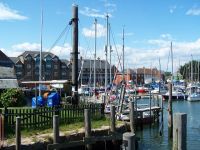Totton and Eling (/ˈtɒtən and ˈiːlɪŋ/) is a civil parish in Hampshire, England, with a population of about 29,000 people. It contains the town of Totton and is situated between the eastern edge of the New Forest and the River Test, close to the city of Southampton but outside the city boundary; the town is within the New Forest non-metropolitan district. Surrounding towns and villages include Ashurst, Marchwood, Cadnam and Ower.
History
Early history
The Iron Age Hillfort at Tatchbury Mount is evidence of early settlement in the Totton area and Netley Marsh on the edge of Totton was the site of an early battle between Anglo Saxon invaders under Cerdic and Romano-Celtic peoples under Natanleod. The construction of Testwood Lakes revealed a treasure-trove of ancient artefacts including one of the oldest known bridges in England, believed to date to around c.1,500BC. The area's history is inevitably closely connected with ship and boat building but more with its timber trade. It was the site of much illegal dealing in the timber unlawfully obtained from the New Forest.
Eling's attractions include the parish church and Eling Tide Mill Experience. St Mary's is a Norman church built on Saxon foundations with registers dating back to 1537. The Eling Tide Mill Experience is Eling Tide Mill, its visitor centre, and the outdoor walks around the mill pond at Bartley Water and the Solent Water shoreline at Goatee Beach. Eling Tide Mill is one of the very few working tide mills in the UK but cannot be equated with the mill listed in the Domesday Book. Hampshire's only surviving medieval toll bridge is here, across Bartley Water by the side of the Tide Mill. This has been in use since at least 1418 and still charges users today. The Eling Tide Mill Experience was closed for refurbishment from 2015 and reopened 9 April 2018.
Recent history
The original village of Totton can be described as the areas of Totton, Testwood and the Salmon Leap, dissected by
